As you likely know, blinds and shades have markedly different styles. Yet, beyond their lovely aesthetics, they vary widely in other ways, too. Among them are the ability to:
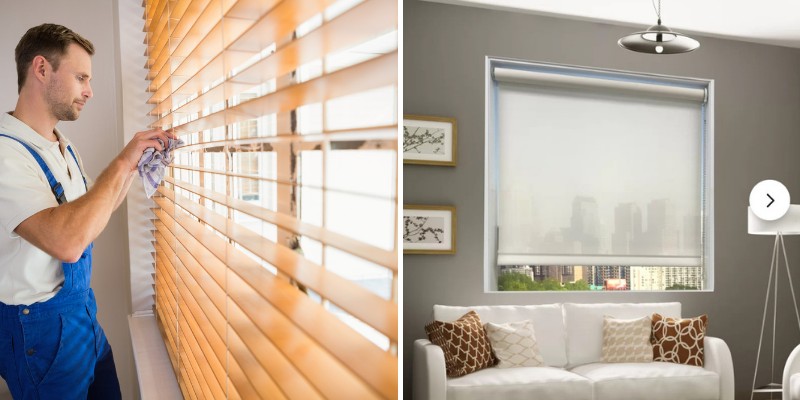
- manage sunlight
- confer privacy
- block frigid drafts and sweltering heat
- stand up to daily use
- fit your budget
With this post, I help you decide which window treatment option between blinds vs shades will serve you best.
So, as you read and view the photos, take note of the features you value most. This way, after installing your new window treatments, you’ll be totally pleased!
Blinds (structure, material etc)
Rigid Framework
Window blinds consist of horizontal fins or vertical panels. Due to their rigid construction, they’re called “hard window treatments.”
By tilting the fins, you govern the amount of light entering a given room. Even if you close the slats completely, they allow some light to pass through. Meanwhile, you can peek outside without anyone seeing you.
On manual blinds, you raise and lower the fins with a pull cord. For greater ease, choose motorized blinds, operated with a remote control.
Remarkably, motorized systems use little power. In fact, the batteries in remotes can last up to five years!
Sturdy Qualities
Blinds come in several enduring materials. Many homeowners opt for wood and woven wood blinds, both sturdy and homey. Other trusted options are vinyl, faux wood, aluminum, and PVC.
Shades (structure, material etc)
Soft Textiles
Window shades are made of a single piece of synthetic or natural fabric. Thus, they classify as “soft window treatments.” Shade material flows in a continuous roll, mounted at the top of a window.
With a standard shade, you raise and lower it manually, usually with a pull cord. As with blinds, you can also get motorized systems. Power sources can be solar, batteries, or your home’s electrical system.
Woven Fabrics
With shades, you have countless fabrics from which to choose! On the more affordable side are nylon and cotton.
At the costlier end are silk, linen, and fiberglass. The specific weave of a given fabric determines how much sun protection it provides.
Other synthetics available are resin, polycarbonate, vinyl, polyethylene, and PVC.
Moreover, you can get room-darkening and blackout shades in acrylic-coated polyester. Such window treatments can foster better sleep in bedrooms and nurseries.
Blinds Styles
There are two basic styles of blinds, horizontal and vertical. Both have a formal, organized, and neat appearance. Here’s how they differ.
Horizontal Blinds
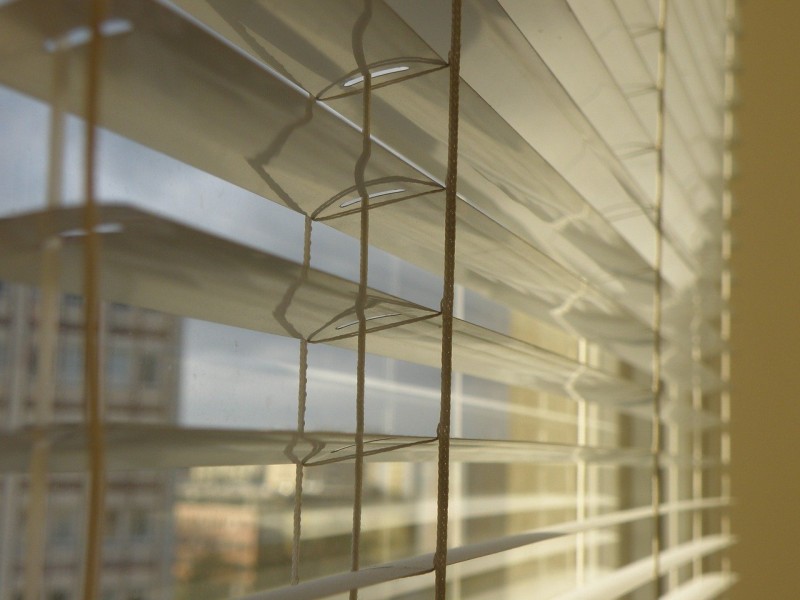
On standard kinds, the fins are 1 to 2 inches wide, running across a window. With mini blinds, the slats are narrower, typically 1 inch wide.
Do you have children or pets? If so, for their safety, you can buy cordless mini blinds, raised and lowered by grasping the bottom frame.
Horizontal blinds fit all window dimensions. Still, they’re easiest to operate on small to medium frames.
Vertical Blinds
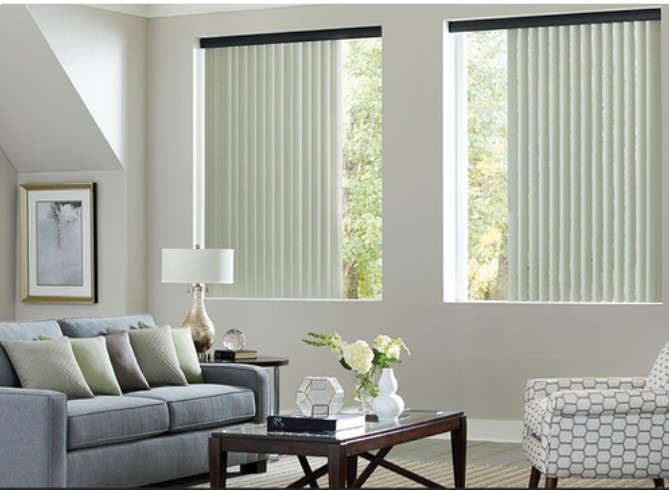
If a given room has large windows, you might opt for vertical blinds.
With this design, the fins are called “vanes.” They measure up to 2½ inches wide, spanning a window from top to bottom.
The vanes originate from an upper rail mounted to your wall or ceiling. Below the rail is a track with “carrier clips” attached to the vanes.
Operation is by grasping a chain pulley or twirling a vertical wand. Either way, you can angle the vanes or draw them across a window.
Shades Styles
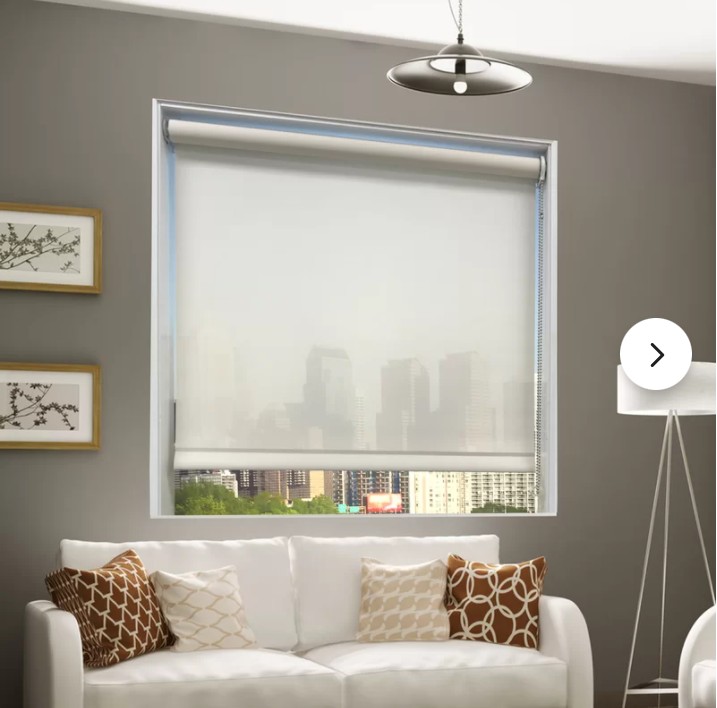
Shades are available in a vast selection of styles and types!
I’m sure you’re familiar with basic roller shades, the springboard to all the rest. Cellular shades have a honeycomb profile.
Roman shades come in five types of folds, and pleated shades have pointy edges.
Solar shades deflect ultraviolet light, shielding your eyes, skin, and furnishings from sun damage.
Practicalities
Now that we’ve explored the external features of blinds and shades, let’s compare their practical value. We’ll discuss:
- sunlight control
- privacy
- durability and longevity
- insulation
- cleaning
- costs
This way, you can pick the optimal window treatment for a given room.
1. Sunlight Control
In this regard, blinds take the lead. Due to their slats, you can tweak the amount of sunlight beaming into a room. Moreover, you can direct the light and where it streams.
With shades, you don’t have this fine-tuned level of control. Still, you can mute sunlight, bathing a room in a gentle glow.
Some types of cellular shades do this nicely. Or you can block sunlight completely, such as with lined Roman shades.
2. Privacy
With shades fully lowered, you may think you’re invisible to curious bystanders. However, sheer fabrics create silhouettes of objects.
So, while outsiders can’t pick out details, they can still see shadowy figures. Hence, for complete privacy, a shade must have opaque material, such as vinyl.
Conversely, when blinds are totally shut, they block outsiders’ views. Although the slats permit some light, no one can actually see inside.
3. Durability and Longevity
Blinds tend to handle daily life better than shades. Still, future longevity depends upon their materials. For instance, if kids or pets yank aluminum blinds, the slats can bend. On vinyl blinds, the fins can break.
Even without kids or pets in your home, blinds can still malfunction. Repetitive use can jam or degrade the mechanisms. For long-lasting blinds, pick those made of wood, woven wood, or PVC.
Since shades consist of fabric, they can tear, especially thin material. Most prone to damage are cellular shades.
4. Insulation
Shades win this category, hands down! Several styles can lower your energy bills year-round.
They can either cut heat loss during winter or keep your home cooler in summer. Some shades do both. Below are stellar insulators.
- Solar Shades – Woven, treated materials ban sunlight and repel heat, easing the workload on cooling systems. However, their porous fabrics allow heat loss during winter. Thus, solar shades are best if you live in a warm climate.
- Cellular Shades – Their honeycombed channels trap air, creating a barrier between your window and room. Thus, they prevent energy transfer during cold and hot seasons.
- Roman Shades – For optimal energy efficiency, buy them with heavy liners.
Conversely, blinds let indoor heat escape during cold months. Still, during warm seasons, if you shut blinds completely, they can help to reduce solar heat gain.
5. Cleaning
With blinds, removing dust is easy. To clean wood and woven wood styles, use a soft, dry cloth or a vacuum with a brush attachment.
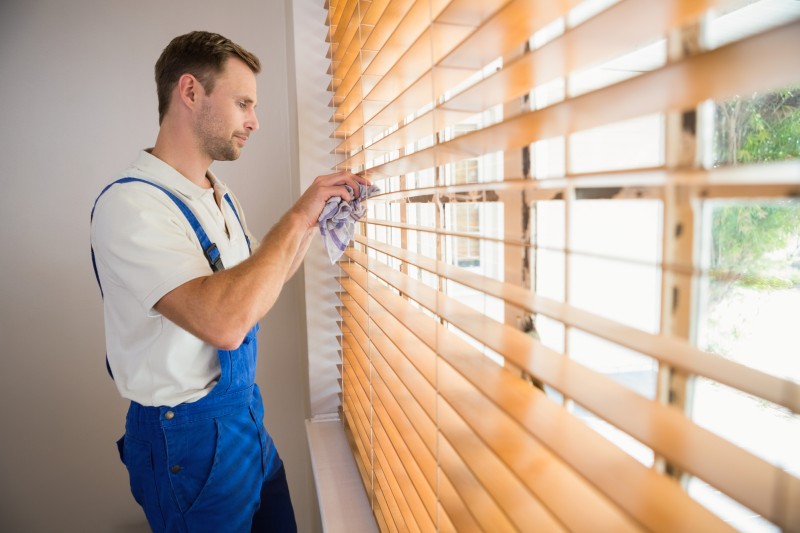
For non-porous blinds, such as vinyl, wipe them down with a damp cloth and mild household cleaner. Or, to eliminate dust alone, vacuum the slats with a brush tool.
Moreover, both aluminum and vertical blinds resist dust!
Shades are another story. Due to their fabric construction, they absorb odors. In your kitchen, any food spatters can render stains. Plus, lingering dust can turn to grime. So, for a thorough cleaning, you may need to hire a professional.
Still, there are two welcome exceptions! Cellular shades repel dust, quickly banished with a vacuum brush attachment. Since roller shades are smooth, all they need is a damp cloth or speedy vacuuming.
6. Costs
Prices vary widely for both blinds and shades, hinging on several factors. Among them are materials, construction, and style. Additionally, labor and installation costs depend on where you live.
Still, shades have more custom options than blinds, making them pricier overall.
Winning Uses
Living Room
In this room, take into account your window size, style, and furnishings.
Are your living room windows floor-to-ceiling? In that case, vertical blinds will suit their spaciousness. Or, are your windows wider than tall? If so, vertical blinds will balance their dimensions, making your ceiling look higher.
Plus, by changing the slat position, you can adjust the blinds for light control and privacy.
These coverings are best for small to medium-sized windows. Roman shades come in many exquisite styles and fabrics. Thus, you’ll find an upscale match for your living room.
Note that Roman shade fabrics can be heavy. Thus, on wide or long windows, they can be tough to raise and lower manually.
Is your living room prone to energy loss? If so, cellular shades can make it toasty in winter and cooler in summer. Since the shades come in a broad color palette, they coordinate with most living room furnishings.
Standard cellular shades are sold in two types of fabric, light-filtering or room-darkening. So, for your living room, choose the light-filtering kind.
Bedroom
Here, the factors to gauge are privacy, light control, and versatility. The best window treatments ably support both daytime activities and nightly sleep. They also have a serene ambiance and insulating properties.
By day, these coverings deflect the sun’s ultraviolet (UV) rays. Come evening, they confer soothing darkness, priming you for sleep.
Moreover, the shade’s thick material muffles outdoor noise. It also provides insulation, moderating your bedroom temperature.
These window treatments are fun to use! A day/night shade has two expandable shutters, each with different fabrics, mounted on separate tracks.
One fabric is sheer and flush with your window, diffusing its light. The second shutter has a room-darkening material.
On the window side, the honeycomb chambers trap UV rays. At night, the blackout fabric ushers you into relaxing slumber.
Additionally, the honeycomb cells have foam insulation. Thus, they prevent energy loss while muting exterior noise.
Most day/night cellular shades are cordless, featuring a tab at the top of the tracks. Simply grasp the tab to raise and lower each shutter. This video shows you how.
For a dreamy look to your bedroom, choose Roman shades with muted colors and gentle folds. Blackout types have dual panels, each coiled on a single roller.
The panel facing the window filters daylight, casting a soothing glow. At nightfall, the heavier weave on the opposite side dims your bedroom, lulling you to sleep.
Bathroom
In your restroom, a window covering should ensure privacy while preventing moisture buildup. Ideally, it should also provide adjustable light control. This way, your bathroom can look bright and airy during the day.
Vinyl and aluminum fend off mold and mildew. Even with the fins completely shut, cheery sunlight can filter through.
Genuine wood can rot, warp, and crack with humidity. Meanwhile, faux wood blinds are unfazed. Their waterproof fins stay smooth, staving off moisture and mildew.
Faux wood blinds come in a range of neutral colors. Still, many homeowners choose white for its mood-lifting aura. Moreover, white window coverings make a petite bathroom seem bigger.
Does your bathroom have a modern or contemporary design? If so, opt for roller shades. Their clean lines are the perfect complement.
Vinyl roller shades are ideal, resisting moisture buildup. Should they get mildew, just wipe them down with a mild soap solution.
Vinyl roller shades come in various opacities and hues. Thus, they’re amenable to most bathrooms.
Since honeycomb cells breathe, cellular shades disperse moisture. Meanwhile, they grant total privacy while bestowing natural light.
Is your bathroom drafty in cold weather? If so, the insulating power of cellular shades will help to keep you warm.
Do you have a top-floor bathroom? In that case, install top-down, bottom-up cellular shades. Since no one can see you from above, you can relax. Meanwhile, the shades ensure privacy at eye level and below.
Kitchen
Here, a key factor is whether your kitchen windows are in a splash zone. This is an area subject to splashing water, food splatters, and rising steam.
Examples of window splash zones are near your stove, above your sink, and in other food prep areas.
Splash Zone Options
PVC-based window coverings work well in splash zones. That’s because they handle water and steam without warping. Plus, PVC cleans readily with soapy water.
Faux wood blinds are classy, retaining their polished look for decades. Plus, they give you precise control of sunlight. Or, choose vinyl roller shades, which you can customize to blend with your kitchen décor.
Safe Zone Choices
Are your windows safe from contact with water, grease, food splatters, and steam? If so, consider Roman shades with a soft drape and pretty patterns.
Their charming beauty can raise the spirits of all who enter your kitchen. Or, for a grounding effect, install Roman shades in plain fabrics and symmetric folds.
Do your kitchen windows have southern or western exposures? If so, sheer roller shades can soften their brilliant light, muting it to your comfort.
Dining Room
Since you likely serve guests in this gathering space, pick tasteful, refined window treatments, as below.
These window coverings are textured wood, setting a relaxed tone for your meals. For an exotic look, install woven bamboo or reed shades. Some manufacturers add a matching valance, a finishing touch.
Do your dining room windows have gorgeous views? If so, invite your guests to enjoy them with solar shades. Meanwhile, the treated fabric shields their eyes and skin from the aging effects of UV rays.
Typically, solar shades come in varying opacities. Choose those that filter light while allowing expansive views.
How does this style differ from the standard? Premium Roman shades have posh fabrics and elaborate designs.
For instance, a hobbled fold has soft edges, cascading gently. Conversely, a flat fold with a batten back descends in smooth pleats.
Typically, a liner is included, either light-filtering or room-darkening. Also, many premium Roman shades give you the option of a cordless or motorized lift. For a large Roman shade, choose a continuous cord loop, facilitating operation.
This natural window treatment is stunning! If you have wood floors or furnishings, install blinds with a coordinating wood stain.
Or, pick a different style matching your dining room décor. Wood blinds come in a broad selection. Plus, you can adjust the slats, fine-tuning the sunlight blessing your dinner guests.
For a streamlined look, choose privacy wood blinds. Compared to standard types, the slats are completely smooth, lacking holes.
Instead, the lift cords run outside the fins. For this reason, they’re also called routeless blinds. As such, they banish glare, UV rays, and leaking light.
Does your dining room have a traditional design? If so, consider faux wood blinds. Like genuine wood, they gleam with the same rich patina. Plus, they’re more durable, affordable, and easier to clean, made of polyester or PVC.
Best of Both
Lastly, let’s clarify what to choose for a given room. Here are highlights of the above comparisons.
BLINDS
Pros
- precise sunlight control
- good privacy, blocking sightlines
- a cinch to clean
- less costly compared to shades
Cons
- non-insulating
- durability depends on the material
- can malfunction with long-term use
- fewer styles than with shades
SHADES
Pros
- variable sunlight control
- good privacy with opaque materials
- outstanding insulation
- vast array of styles and textiles
Cons
- sheer fabrics can rip
- odors, stains, and grime may need professional cleaning
- generally more expensive than blinds
Now you know which blinds and shades can best suit your purposes. Also, for specific rooms in your home, you have several fantastic options.
Picture your windows, modeling their new accessories, smiling at you. Moreover, your family and guests will love them, too!
Related Posts
- How to Protect Sliding Glass Doors from Burglars: Essential Security Tips
- How Long Do Sliding Glass Doors Last? Durability and Lifespan Explained
- Here Are Some Pros and Cons of Textured Walls in Homes
- Why Do Sliding Doors Get Stuck? Common Causes and Solutions
- Comparison of Knockdown Drywall Texture vs Orange Peel
- Some FAQ (Frequently Asked Questions) About Wall Paneling for Homes
Leave a Reply